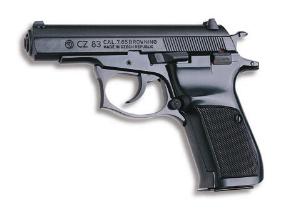The Guns of
Czechoslovakia
by Kirby Sanders (USA)
Technical and research
assistance - Jan Balcar (Czech Republic)
As the 21st Century begins, there is a new European
contender is making great economic headway in the Western
Firearms business-- a "new contender "that has been
manufacturing firearms since the end of World War One.
This contender has come from the back of the pack in
western markets -- having been held there by German occupation
throughout WWII followed immediately by dominion of the Soviet
Union throughout the Cold War. After independence from Soviet
control via the Velvet Revolution of 1989, firearms from
Czechoslovakia rapidly gained noticeand acceptance for their
quality in the Western collector and commercial markets
The company that is now referred to as "CZ"
is an amalgamation of earlier companies and firearm-designs
forged in the crucible of geopolitics. These several small
companies were, over time, merged via market acquisition or
government fiat into an emerging market powerhouse under a free
Czech Republic
The area most commonly known as Czechoslovakia
initially fell under Hapsburg rule in the 16th Century and had
been a part of the Austro-Hungarian Empire through WWI. The area
was also critical to that empire's Industrial Revolution in the
late 18th Century due to its mountainous terrain and ready
availability of swift-moving mountain streams to power
water-driven engines of industry. Like the Ruhr Valley for Krupp
and the development of German firearms technology, topography
made Czechoslovakia a natural for the growth of industry.
A long-dormant nationalism and desire for self-rule
was also rife in the area during that early technological
"revolution." The Czechs and Slovaks did not do well
under Austro-Hungarian domion and the period during WWI saw
several demonstrations and strikes protesting that War. At the
end of The War to End All Wars (and the beginning of the history
of CZ), Czechoslovakia became a free and self-governed state in
October, 1918.
Among the many conditions set upon a defeated
Austro-Hungarian Empire in the Treaty of Versailles was a ban on
Germany's manufacture of military firearms and severe
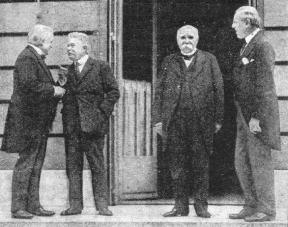
The
Big Four
Lloyd
George of Great Britain, Orlando of Italy, Clemenceau of
France and Woodrow Wilson of the United States at the
Conference of Versailles
(from
Literary Digest July 5, 1919)
|
curtailment of the production
of other war materielle.
Upon institution of the bans,
Mauser in Germany was forced to cease manufacture of all
military firearms including their famous rifles.
The company moved to production
of the "Standard Modell," a sporting rifle that
also happened to make a pretty reputable military arm.
Licensed production of Mauser military rifles was granted
to Czechoslovakia and to Fabrique National in Herstal,
Belgium.
In 1921, the free Czech armorers
began a good practice building Mauser 98/22s- a licensed
version of the already successful m98.
|
A company separate from what is now CZ, Ceskoslovenska
Statni Zbrojovka Brno (the Czechoslovak State Arms Factory in
Brno) was licensed to produce Mauser-pattern Rifles.
"Zbrojovka Brno" was initially a subsidiary
of the Vienna Arsenal established in 1917 in nearby Zabrdovice.
On January 20, 1919, the Czech Ministry of Defense assigned
Zbrojovka Brno its first-year missions which varied from the
construction of railway coaches to the repair of damaged
Mannlicher rifles and the production of hand-grenades designed by
native-son Frantisek Janecek.
| m98 TECHNICAL
SPECIFICATIONS |
| Caliber |
7.92
mm |
| Velocity
V0 |
870
m/s |
| Ammunition |
8mm
Mauser (js) |
| Weight
(with empty magazine) |
???
g |
| Weight
(with full magazine) |
???
g |
| Total
length |
1244
mm |
| Barrel
length |
724
mm |
| Magazine
capacity |
5 |
| Effective
range |
1000
m |
|
 Czech Mauser m98
Kirby
Sanders collection
|
The initial-production Zbrojovka Brno rifle was the
standard Mauser Gewehr 98 constructed using parts from Germany.
Between the plant at Brno and a smaller facility at Bystrica,
approximately 42,000 of these initial GEW 98 rifles were
produced. Most of these rifles were manufactured to honor a
standing contract commitment between Mauser and the government of
Turkey.
Additional
info re: 98/22
| VZ98/22 TECHNICAL
SPECIFICATIONS |
| Caliber |
7.92
mm |
| Velocity
V0 |
870
m/s |
| Ammunition |
8mm
Mauser (js) |
| Weight
(with empty magazine) |
???
g |
| Weight
(with full magazine) |
???
g |
| Total
length |
1244
mm |
| Barrel
length |
724
mm |
| Magazine
capacity |
5 |
| Effective
range |
1000
m |
|
 VZ98/22 Mauser
Kirby
Sanders collection
|
Zbrojovka Brno moved from production of the licensed
m98 in 1924 with the introduction of their own Mauser-based
design, the VZ24.
ADDITIONAL INFO
RE: VZ24
| VZ24 TECHNICAL
SPECIFICATIONS |
| Caliber |
7.92
mm |
| Velocity
V0 |
870
m/s |
| Ammunition |
8mm
Mauser (js) |
| Weight
(with empty magazine) |
???
g |
| Weight
(with full magazine) |
???
g |
| Total
length |
1092
mm |
| Barrel
length |
578
mm |
| Magazine
capacity |
5 |
| Effective
range |
1000
m |
|
 VZ24 Rifle
Kirby
Sanders collection
|
While the shorter-barrelled VZ24 became the modern
weapon of the time in Czech production, CZ had no problems
acquiring contracts from other nations and building various
versions of traditional longer-barelled "98s" as well.
OTHER
CZECH MAUSERS
Beginning with the VZ98/22 and continuing to present,
most Czechoslovakian firearms are referred to by an alpha-numeric
"VZ" designation. "VZ" refers to the Czech
word for "model" or "pattern" (Vzor) and the
numbers generally refer to the date of military acceptance or
initial manufacture. Pistols and rifles have sometimes been
assigned the same designations which can lead to confusion. Many
firearms collectors have dealt with the confusion by referring to
rifle models as "VZ" and pistols as "CZ."
Thus, knowledgeable firearms collectors will be heard referring
to a model VZ24 rifle while the like-designated pistols will be
called CZ24s. To the purist, the proper Czech reference would be
to "Puska vz. 24" (rifle model 24) and to "Pistole
vz. 24" (pistol model 24).
The similarity of names between early long-arms
producer Zbrojovka Brno and their counterpart for pistols, Ceska
Zbrojovka has also created some confusion for collectors. By time
and consolidation, both companies eventually were merged under
the name of Ceska Zbrojovka. Early model pistols and rifles,
however, are most properly differentiated even though both share
"VZ" as model designators and are often referred to as
"CZ" firearms
As a rule of thumb, rifles produced before Communist
take-over in the 1940's should be referred to as Ceskoslovenska
Zbrojovka and most pistols referred to as Ceska Zbrojovka.
Czechoslovakian rifles have been preferred by several
nations from the beginning of the industry. VZ98/22s or VZ24s
were produced under contract for the Czech military, Turkey,
Germany during Nazi occupation, Spain, Guatemala, Romania and
Iran.
| Ceskoslovenska Zbrojovka Brno's trademark was
the letter "Z", inside a rifled bore. With
the CZ22, Zbrojovka Brno pioneered a design standard that
would carry well into production of the later, purely CZ,
pistols even though the early CZ22 was not a particularly
reliable military firearm.
The CZ 22 was designed by Mauser designer
Josef Nickl
|

Ceskoslovenska
Zbrojovka Brno trademark
|
for a cartridge dimensioned the same as the modern
9x17 millimeter or ".380acp". The 9mm Vzor22 cartridge,
however, held a stouter charge of powder, making it a slightly
more powerful round than the modern .380. Many collectors who
report feeding and ejection problems when shooting the various
Czech 9x17 pistols are likely suffering from "light"
modern powder charges rather than problems with the firearm.
PHOTO /
DESCRIPTION OF vZ22 and Mauser m1914
| VZ22 TECHNICAL
SPECIFICATIONS |
| Caliber |
9
mm |
| Velocity
V0 |
???
m/s |
| Ammunition |
9x17
vzor22 |
| Weight
(with empty magazine) |
560
g |
| Weight
(with full magazine) |
???
g |
| Total
length |
147
mm |
| Height
of the gun |
124
mm |
| Barrel
length |
87
mm |
| Magazine
capacity |
??? |
| Effective
range |
???
m |
|
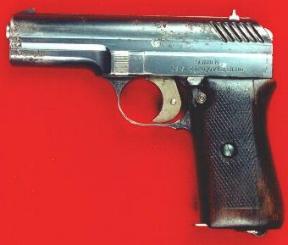 VZ22
photo
courtesy of Jan Balcar
|
| The VZ22 pistol has an external hammer and is
in many ways reminiscent of the Mauser model 1914. The
VZ22 uses a rotating barrel-recoil breech system. |
| Approximately 20,000 VZ22 pistols were
produced for military use during 1922 and 1923.
Czechoslovakia's first home-grown auto-loading pistol, it
was adopted by the Czechoslovak Army. Problems arose with
parts interchangability, however. Those problems combined
with clumsy ergonomics and a delicate internal design
created problems for the early VZ22s. The
VZ22 was redesigned by Frantisek Myska in 1921 in an
effort to overcome some of the early shortcomings for the
Army. The VZ22 was the last pistol model designed by
Zbrojovka Brno.
|
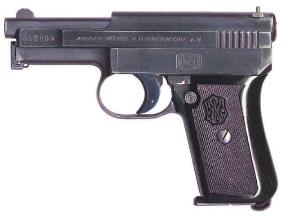 Mauser m1914
photo
courtesy of Gerhard Schoenbauer
|
Some of the earliest Czech semi-automatic pistols were
produced outside of the Ceska Zbrojovka umbrella. The company
Zbrojovka Praga produced the Praga 1919 and Praga 1921
semi-automatic pistols. Zbrojovka Praga was founded under the
auspices of the old, family-owned business of J. Nowotny on Jan.
5, 1918.
Zbrojovka Praga's Praga 1919 is a simple blow-back
pistol in 7.65mm Browning caliber-- a standard .32acp. It was
tested but rejected for use by the Czech military in 1920.
Despite the overall contract rejection approximately 3,000 Praga
1919s were accepted by the Czech military out of an estimated
overall production of 11,200.
PRAGA
1919 TECHNICAL SPECIFICATIONS
|
| Caliber |
7.65
mm |
| Velocity
V0 |
???
m/s |
| Ammunition |
.32acp |
| Weight
(with empty magazine) |
595
g |
| Weight
(with full magazine) |
???
g |
| Total
length |
167
mm |
| Height
of the gun |
104
mm |
| Barrel
length |
97.3
mm |
| Magazine
capacity |
6 |
| Effective
range |
???
m |
|
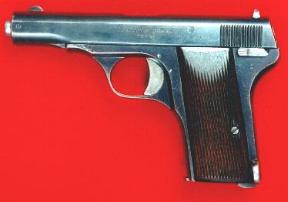 Praga m1919
photo
courtesy of Jan Balcar
|
|
The Praga 1921 is a small .25 caliber
"vestpocket" pistol of unusual design. The Praga 1921
has a folding trigger for ease of pocket-carry and a shallow
groove along the slide intended to ease single-handed cocking of
the pistol. Approximately 7,400 of these pistols were produced.
Praga Zbrojovka fell to bankruptcy in 1926 at which point all of
Praga's remaining pistol production ceased.
PRAGA
1921 TECHNICAL SPECIFICATIONS
|
| Caliber |
6.35
mm |
| Velocity
V0 |
???
m/s |
| Ammunition |
.25acp |
| Weight
(with empty magazine) |
350
g |
| Weight
(with full magazine) |
???
g |
| Total
length |
107
mm |
| Height
of the gun |
83
mm |
| Barrel
length |
52
mm |
| Magazine
capacity |
6 |
| Effective
range |
???
m |
|
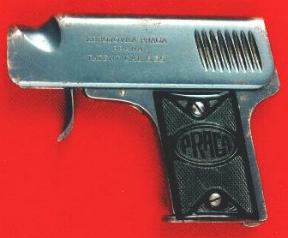
Praga
1921
photo
courtesy of Jan Balcar
|
|
Three other independent pistol manufacturers arose in
the early 1920s-- Slavia, DUO and Alois Tomiska.
| SLAVIA TECHNICAL
SPECIFICATIONS |
| Caliber |
6.35
mm |
| Velocity
V0 |
???
m/s |
| Ammunition |
.25
Browning |
| Weight
(with empty magazine) |
400
g |
| Weight
(with full magazine) |
???
g |
| Total
length |
116
mm |
| Height
of the gun |
89
mm |
| Barrel
length |
53mm |
| Magazine
capacity |
6 |
| Effective
range |
???
m |
|
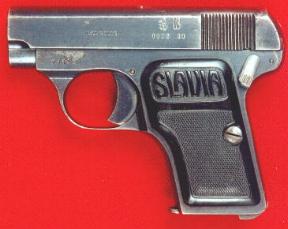 SLAVIA (1931)
photo
courtesy of Jan Balcar
|
|
Manufacturer Antonin Vilimec began Slavia at the town
of Kdyne. Slavia produced copies of the Belgian Fabrique
Nationale m1906. Slavia was taken over less than a decade later
by the Sumava Heights Armory (Kohout and Company). Sumava-Kohout
manufactured abrique Nationale model 1906 and 1910 copies called
the "Mars," the "PZK" and the
"NIVA."
| MARS (PZK) TECHNICAL
SPECIFICATIONS |
| Caliber |
6.35
mm |
| Velocity
V0 |
???
m/s |
| Ammunition |
.25acp |
| Weight
(with empty magazine) |
370
g |
| Weight
(with full magazine) |
???
g |
| Total
length |
117
mm |
| Height
of the gun |
89
mm |
| Barrel
length |
53
mm |
| Magazine
capacity |
6 |
| Effective
range |
???
m |
|
 MARS (PZK)
photo
courtesy of Jan Balcar
|
|
The NIVA is an unusual variety of the more common Mars
pistol. A very limited presentation-model, these pistols were
made after World War II and given to surviving members of the
Czech resistance. Only 37 were made.
| NIVA TECHNICAL
SPECIFICATIONS |
| Caliber |
7.65
mm |
| Velocity
V0 |
???
m/s |
| Ammunition |
.32
Browning |
| Weight
(with empty magazine) |
750
g |
| Weight
(with full magazine) |
???
g |
| Total
length |
165
mm |
| Height
of the gun |
775
mm |
| Barrel
length |
90
mm |
| Magazine
capacity |
6 |
| Effective
range |
???
m |
Even the name NIVA was a tribute
to these men. Meaning "Mountain Green," the
pistols were given the name used during the war to refer
to the resistance itself. NIVA pistol serial number 1 was
given to General Bohumil Bocek.
General of the Army immediately
up to and during the Nazi Invasion of 1939, Bocek was
also a member of the Czech government-in-exile in London
during 1939 and 1940. He joined the Allied cause as a
fighting member and commander of
|
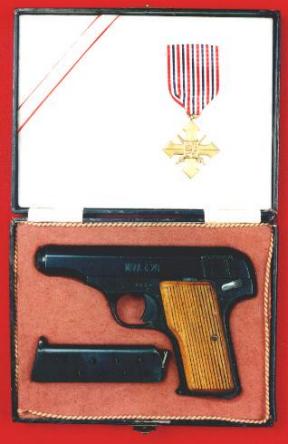 NIVA #20 (PZK)
photo
courtesy of Jan Balcar
|
|
the 1st Czechoslovak Brigade in Russia and served as
Comanding General of the Czech Army from 1945 until 1948. Retired
from the army by 1950, he was jailed by the Communist government
in 1951 as "a man who knew too much" and died in in the
State Prison in 1952.
NIVA pistol number 1 is on display in the Army Museum
in Prague.
The pistol trade-name DUO was an acronym for
"Dusek in Opocno" and the DUO pistol may also be called
the "Jaga." These were produced between 1920 and 1948
and are a small copy of the FN 1906 pocket-pistol. The modern CZ
factory produced a "DUO" model in .25 caliber through
1958.
DUO
TECHNICAL SPECIFICATIONS
|
| Caliber |
6.35
mm |
| Velocity
V0 |
???
m/s |
| Ammunition |
.25acp |
| Weight
(with empty magazine) |
350
g |
| Weight
(with full magazine) |
???
g |
| Total
length |
113
mm |
| Height
of the gun |
77
mm |
| Barrel
lenght |
53
mm |
| Magazine
capacity |
6 |
| Effective
range |
???
m |
|
 DUO
photo
courtesy of Jan Balcar
|
|
DUO
"Z" TECHNICAL SPECIFICATIONS
|
| Caliber |
6.35
mm |
| Velocity
V0 |
???
m/s |
| Ammunition |
.25acp |
| Weight
(with empty magazine) |
380
g |
| Weight
(with full magazine) |
???
g |
| Total
length |
114
mm |
| Height
of the gun |
77
mm |
| Barrel
length |
53
mm |
| Magazine
capacity |
6 |
| Effective
range |
???
m |
|
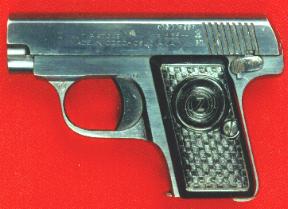
DUO
"Z" cal. 25 (1950s)
photo
courtesy of Jan Balcar
|
DUO
"Z" .22 TECHNICAL SPECIFICATIONS
| Caliber |
.22 |
| Velocity
V0 |
???
m/s |
| Ammunition |
.22short |
| Weight
(with empty magazine) |
300
g |
| Weight
(with full magazine) |
???
g |
| Total
length |
128
mm |
| Height
of the gun |
78
mm |
| Barrel
length |
66
mm |
| Magazine
capacity |
6 |
| Effective
range |
???
m |
|

DUO
"Z" cal. 22short
photo
courtesy of Jan Balcar
|
Alois Tomiska of the town of Pilsen originated the
double-action vestpocket pistol with the introduction of this
vestpocket .25 caliber. Tomiska means "Little Tom" in
Czech and the pistol became called the same-- Little Tom. They
were produced from 1919 to 1923.
LITTLE
TOM TECHNICAL SPECIFICATIONS
|
| Caliber |
6.35
mm |
| Velocity
V0 |
???
m/s |
| Ammunition |
,25acp |
| Weight
(with empty magazine) |
370
g |
| Weight
(with full magazine) |
???
g |
| Total
length |
114
mm |
| Height
of the gun |
83
mm |
| Barrel
length |
58
mm |
| Magazine
capacity |
6 |
| Effective
range |
???
m |
|
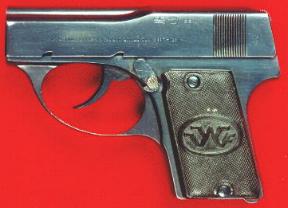 Little Tom
photo
courtesy of Jan Balcar
|
|
Concurrent with the growth of Zbrojovka Brno, Ceska
Zbrojovka was founded in 1919 in Plzen, Czech Republic, as
Jihoceska Zbrojovka-- the South Czechoslovakia Arms Factory. The
company was established with management assistance from the Skoda
Works.
Skoda manufactured steam locomotives, turbines and
machine tools as well as military vehicles, artillery pieces and
artillery munitions. The first gunsmithing shop was established
in the former Halbemeyer Mill under technical director and
manager Alois Tomiska. The old Skoda plant still exists in Plzen,
however the river so critical to its early operation has changed
course-- leaving the plant high and dry.
The first Jihoceska product was the Fox automatic
pistol. The Fox was a .25 calibre vestpocket with folding trigger
with a pressed sheet-metal frame. Fewer than 1500 Fox pistols
were made andthey are now a rarity.
 FOX PISTOL
photo
courtesy of J.B.
|
| FOX TECHNICAL
SPECIFICATIONS |
| Caliber |
7.65
mm |
| Velocity
V0 |
???
m/s |
| Ammunition |
9mm
x 17 |
| Weight
(with empty magazine) |
???
g |
| Weight
(with full magazine) |
???
g |
| Total
length |
???
mm |
| Height
of the gun |
???
mm |
| Barrel
lenght |
???
mm |
| Magazine
capacity |
6 |
| Effective
range |
???
m |
|
| Jihoceska Zbrojovka moved operations to a new
factory at Strakonice in 1921 and, in 1922, merged with
another small firearms concern. That other facility, the
Hubertus Factory, produced firearms for two large
gunshops in Prague at the time. With this merger,
Jihoceska also took the name Ceska Zbrojovka -- The Czech
Arms Factory. There are several early
trademarks for Ceska Zbrojovka. Military arms were
generally marked with a C and an arrow pointing upward to
a Z. Commercial or private-use firearms were initially
marked "CZ", with the "Z" inside of
the "C" and the "C" within a circle.
The company eventually standardized to the latter mark,
however.
In 1958, the CZ logo was again modified to
reflect a reorganization and intergration into the
state-owned October Revolution Works, Vsetín, as Works
No. 05 Uherský Brod. This logo featured a
pistol-in-profile within a circle and the name
"Slavia" beneath.
In 1992, the modern CZ was established with
the privatization and establishment of the company in asa
free-market entity. The logo for the modern CZUB is the
pistol-in-profile within a circle with the letters CZ
beside.
Czechoslovakia's military pistol design
changed somewhat with the introduction of the first true
"army pistol", the Vzor 24.
While the principle of the VZ24 is much like
that of the VZ22, the VZ24 was much better-engineered at
closer tolerances to suit military specifications.
Approximately 197,000 VZ24s were produced at
|

Initial
logo

1958
logo

Modern
logo
|
Strakonice between 1924 and 1927. The CZ24 was
returned to the 9m-short Vzor22 cartridge. These pistols were for
Army and police use and none were sold commercially within
Czechoslovakia.
There reportedly were some sales made to the
governments of Latvia and Colombia and 3,285 were sold to Finland
for use during their 1939-1940 Winter War with Russia.
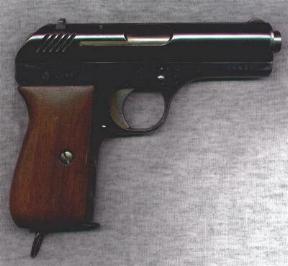 CZ24
Kirby
Sanders collection
|
| CZ24 TECHNICAL
SPECIFICATIONS |
| Caliber |
9
mm |
| Velocity
V0 |
???
m/s |
| Ammunition |
9mm
x 17 (vz22) |
| Weight
(with empty magazine) |
???
g |
| Weight
(with full magazine) |
???
g |
| Total
length |
???
mm |
| Height
of the gun |
???
mm |
| Barrel
length |
???
mm |
| Magazine
capacity |
6 |
| Effective
range |
???
m |
|
The Czech police accepted the .32acp caliber CZ vzor
27, in 1927. A simple blowback design semi-automatic, the CZ27 is
similar in appearance to the model 24 but has a flat rather than
round-sided slide.
The CZ27 was produced from 1927 - 1949, but production
was done in three distinct phases. The first 20,500 pistols were
produced for the Czech military between 1927 and 1938. After the
Nazis invaded Czechoslovakia in March of 1939, they kept the CZ27
in production. With serial numbers from 20,501 to 473,000; these
452,499 pistols carry a distinctly German-style set of markings
and stamps. Still produced by the Czechs at Strakonice, the slide
stamp of the German Occupation models read "fnh Pistole
Modell 27 Kal. 7.65" and will carry the Eagle-and-swastika
"waffenamt" stamps common to all Nazi firearms.
| CZ27 TECHNICAL
SPECIFICATIONS |
| Caliber |
7.65
mm |
| Velocity
V0 |
300
m/s |
| Ammunition |
.32acp |
| Weight
(with empty magazine) |
???
g |
| Weight
(with full magazine) |
???
g (+64g) |
| Total
length |
???
mm |
| Height
of the gun |
???
mm |
| Barrel
lenght |
???
mm |
| Magazine
capacity |
8 |
| Effective
range |
50
m |
|
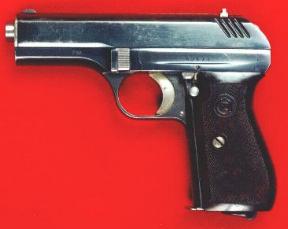 CZ27 pre-WWII
photo
courtesy of Jan Balcar
|
|
Like the Hungarian FEG 37Ms (re-designated the
Pistolen 39-u by the Germans) and Italy's Beretta m34, the CZ27s
remained in production to help fill the German military's
voracious appetite for pistols during WWII. Production of the
CZ27 continued after World WarII and into the Cold War era. Some
147,00 additional CZ27s were manufactured at Strakonice between
1945 and 1949. Total production of the CZ27, until recently a
little-known weapon on the Western side of the Iron Curtain, was
about 620,000 from introduction in 1927 until the end of
production by 1950.
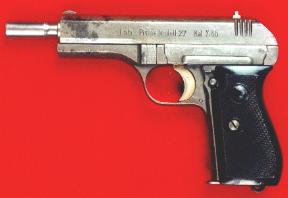 CZ27
(fnh)
with silencer
photo
courtesy of Jan Balcar
|
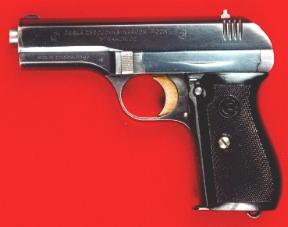 CZ27
post-WWII
photo
courtesy of Jan Balcar
|
As the Nazis were invading, Ceska Zbrojovka had also
been producing the CZ38. Nicknamed the "Nutcracker,"
the model 38 had a hinged barrel and was a simple
blowback-design, double-action pistol . The CZ38 also represented
a return to the "hot .380" designated as the 9mm Vzor22
cartridge. None of the CZ38s saw service in the Czech national
military, as all of that production was captured by the Germans.
Aproximately 1,731 VZ38s were sold to Finland by the Germans in
1939. Some 2,199 went to the Luftwaffe, apparently in 1940, and
the remaining 999 were supplied to Bulgaria in about 1942.
| CZ38 TECHNICAL
SPECIFICATIONS |
| Caliber |
9mm
|
| Velocity
V0 |
???
m/s |
| Ammunition |
9x17
vzor22 |
| Weight
(with empty magazine) |
900
g |
| Weight
(with full magazine) |
???
g |
| Total
length |
195
mm |
| Height
of the gun |
143
mm |
| Barrel
length |
119
mm |
| Magazine
capacity |
??? |
| Effective
range |
???
m |
|
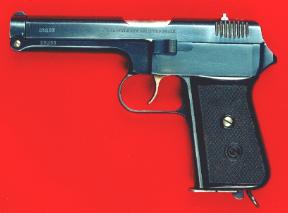 CZ38
photo
courtesy of Jan Balcar
|
|
Pistols were not the only Czech weapons commandeered
or produced under Nazi occupation. The VZ24 rifle produced by
Ceskoslovenska in Brno also saw use in the Wehrmacht. The VZ24
was a Mauser-based design that would even take the German bayonet
in its original configuration. Germany designated the
Ceskoslovenska factory as "Waffenwerke Bruenn A.G."
Occupation-produced VZ24 rifles were receiver-stamped "G.
24(t)", translating essentially to "Model 24
(Czechoslovakia)". Under occupation, the Czechs also
produced a VZ24 variant designated as the model 33/40. Those
rifles were stamped with the factory code "d.o.t."
During the Nazi reign over Czechoslovakia, CZ plants
were also pressed into production of Lehky kulomet vzor 30 light
aircraft machine guns, Raketova vzor 28 and 30 flare launchers,
and three German-pattern machineguns, the MG17, MG 131 and MG81.
Czechoslovakia did not walk gladly into the Nazi camp
during World War II. It should be noted instead, that the free
Czech state was abandoned to the Germans during the period of
Nazi appeasement by the allies at the end of the 1930s. Nor did
the Czechs lie docile under the Nazi thumb.
Celebrations of Czech Independence Day on October 28,
1939 led to a series of demonstrations against Nazi domination
and the shooting death of a young demonstrator, Jan Opletal. On
the day of Opletal's funeral (November17, 1939), another series
of demonstration and clashes with the Nazis broke out. This
tendency of the Czechs to chafe under the master's yoke led
Germany to deal the people one of the harshest of occupations. By
the end of 1939 alone, the Nazis had sentenced nine of the
student-demonstration leaders to death, closed the Czech
Universities and sent 1,200 students to labor and concentration
camps.
| The Czech Resistance during WWII, while
notably small, managed one of the greater resistance
successes during the war. Their members were responsible
for the successful 1942 assassination of Reinhard
Heydrich on a twisting street in Prague by the Bulovka
Hospital. Heydrich was one of the
architects of the "Final Solution" and a
highly-placed Nazi official overseeing the occupation of
the area that included Czechia, the Czech area of
Czechoslovakia, and Moravia.
Soldiers of the Czech Army exiled in England
parachuted into their homeland in search of Heydrich. Two
men with a British Sten gun, Josef Gabcik and Jan Kubis,
located Heydrich in his Mercedes SSK and opened fire.
Gabcik's Sten malfunctioned, but Kubis was able to hit
the vehicle with a homemade bomb.
|
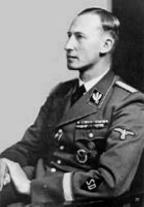 Reinhard Heydrich
|
The explosion did not kill Heydrich immediately,
however, he died of complications from those wounds eight days
after the attack. The
Czech soldiers remained in hiding in the basement of the church
of St. Karel Boromejsky on Resslova street, awaiting an
opportunity for safe escape. One of these men double-crossed his
compatriots, however and told the Gestapo of the group's
hideout. The church was surrounded by the German army and a
firefight ensued. When the outgunned Czechs' ammunition ran out,
all of the Czech soldiers died at their own hands-- a scene
reminiscent of a mini-Masada.
For years after WWII,
the spot by Bulovka Hospital was referred to by Czechs as
"Heydrich's turning."
That success, however, brought another round of
murderous oppression which saw the executions of 1,600 in the
search for the assassins and the absolute destruction of the
village of Lidice. That deadly attack, however focused on a
village that had nothing to do with the resistance attack.
Five days after Heydrich's death, ten
truckloads of Security Police surrounded the village. All 172 of
the men and boys over 16 years old were captured and locked in a
barn. They taken out the next day in groups of ten and all were
shot. The killing reportedly lasted from dawn until 4:00 p.m.
Another 19 men who were working in the mines during the initial
carnage were captured, taken to Prague and executed there.
One woman and a boy were
shot as the Nazis entered the village. Seven of the townswomen
were removed to Prague and executed. The other 195 women of
Lidice were sent to Ravensbrueck concentration camp in Germany
where 49 died (7 were gassed and the balance reportedly died of
ill-treatment). Some 90 children of Lidice were taken to the
Gneisenau concentration camp. There, they were reportedly divided
out by "racial experts" and sent to live with Aryan
loyals to be raised under new German names.
The village was burned,
remaining structures were then dynamited, and the entire site
bulldozed. To this day, Lidice has not been rebuilt.
Not content with the destruction of Lidice for the
killing of Heidrich, the Nazis then torched the village of
Lezaky, killing 54 men, women and children. The Gestapo had
reportedly found a secret radio transmitter in Lezaky
Those repercussions succeeded in crushing the Czech
armed resistance. The Czechs continued civil demonstrations and
disruptions, however until their "liberation" by the
Red Army in 1945. Czechoslokia fell under the domination of the
Soviet Union according to the terms of the Yalta Agreement
between Roosevelt, Stalin and Churchill. Most of the country fell
under the immediate post-war jurisdiction of the Russians save
the area near Plzen which was entered by American troops. The
entire nation, however, soon fell under the administration of the
Soviets.
That quirk of fate or geo-politics also served further
to deprive the west of access to some fine firearms and to
deprive Czechoslovakia of lucrative markets for another
generation of technological advances.
Outside of military production, CZ did produce a
small-caliber "vestpocket" pistol, the CZ36, which
enjoyed some popularity as a defensive firearm on the European
market. also known in German-speaking countries as the "CZ
Tezet" or the "Bruenner Tezet," the CZ36 is a
small and compact double-action-only semi-automatic of the
''vestpocket pistol'' class.
The CZ36 was designed by Frantisek Myska in 1936. It
was later modified and simplified by designer Jaroslav Kratchovil
in 1945. It was subsequently re-designated the CZ45 but the
modifications are nominal. The CZ36 and 45 generally have no
safety switch, being a double action system. Unlike most
semi-autos, the slide does not re-cock the hammer after firing,
again because of the double-action theory involved. Some CZ 36
and 45 were made with safety levers, but are an uncommon sight.
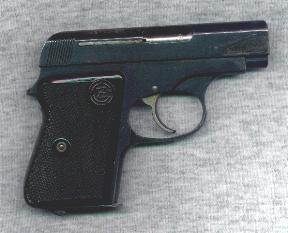 CZ45
Kirby
Sanders collection
|
CZ36
/ 45 TECHNICAL SPECIFICATIONS
|
| Caliber |
6.35
mm |
| Velocity
V0 |
???
m/s |
| Ammunition |
.25acp |
| Weight
(with empty magazine) |
???
g |
| Weight
(with full magazine) |
???
g |
| Total
length |
???
mm |
| Height
of the gun |
???
mm |
| Barrel
length |
???
mm |
| Magazine
capacity |
??? |
| Effective
range |
???
m |
|
The CZ vzor 36 and 45 carries an
8-round magazine and has an overall length of 5-inches. The
barrel is 2.5-inches in the length. The pistol has an empty
weight of only 15 ounces and is a common collectible pistol in
Europe. The new "CZ Model 92," produced since 1992 by
CZ, is the same pistol and pattern and remains in commercial
production with reshaped grips.
For police and limited use by
Communist Party members, CZ brought out the Walther-style vzor 50
pistol in 1950. The vzor 50 was designed immediately following
World War II by brothers Jan and Jaroslav Kratchovil and intended
as a police sidearm. Initially designated as the Model 006 during
development, it was designated the Vzor 50 following the standard
Czech model number / acceptance date standard. It was widely used
as a Czech Police firearm.
| CZ50 TECHNICAL
SPECIFICATION |
| Caliber |
7.65
mm |
| Velocity
V0 |
300
m/s |
| Ammunition |
7,65
x 17 HR |
| Weight
(with empty magazine) |
706
g |
| Weight
(with full magazine) |
770
g |
| Height
of the gun |
122
mm |
| Barrel
length |
96
mm |
| Magazine
capacity |
8 |
| Effective
range |
50
m |
|
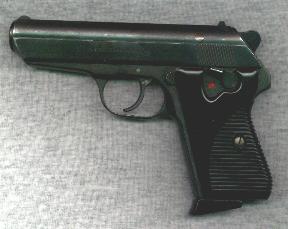 CZ50
Kirby
Sanders collection
|
The first CZ50 (sn 650001) was
numbered to succeed the last CZ27 (sn 650000).
It is a 7.65mm (.32acp) caliber
double-action semiautomatic pistol with a profile very similar to
the Walther PP. The magazine holds 8 rounds. The CZ50 is
approximately 6.7-inches long with a barrel length of
approximately 3.75-inches. Overall empty weight is 24 ounces. The
CZ50 was produced from 1949-1970 with a brief break in production
from 1952-1957. The Czeska Zbrojovka armory at Strakonice was the
initial production site for the the CZ50. CZ ceased production of
the CZ50 and began concentrating on production of the CZ52 for
the military between 1952-1954. CZ - Strakonice ceased all
production of pistols in 1955. Approximately 90,000 CZ50s were
produced at Strakonice between 1950 and 1952 with serial numbers
ranging from 650001 to about 740000.
In 1955, all production of
pistols moved to the Presne Strojirenstvi factory at Uhersky
Brod, where CZ50 production restarted in 1957. It is unknown how
many were produced at Presne Strojirenstvi after 1957, as there
does not appear to have been a single coherent system of
assigning serial numbers. Pistols produced at Presne
Strojirenstvi factory will generally have a five digit numeric
and alpha combination for the serial number. The placement of the
alpha characters changes location within the serial number from
time to time and no determination has been made as to what system
was being used or how many post-1957 pistols were produced.
Early production CZ vzor 50s
will have 6-digit serial numbers. They will also bear the
manufacture marks CESKA ZBROJOVKA on the top line and a lower
line of NAR. PODNIK STRAKONICE on the left slide.
The "Nar Podnik" stamp
denotes CZ as having become a "Narodni Ponik" which is,
essentially, a unified "National Enterprise." These
National Enterprises were the sole manufacturers of certain goods
under the Soviet-style economy. As CZ became a collectivized
industry consolidatingthe production of firearms under a single
state entity at Uhersky Brod, so Ceske Zavody Motocyklove Narodni
Podnik (Czech Motorcycle Works, National Enterprise) became the
sole manufacturers of Czech motorcycles at the old arms plant in
Strakonice.
Later production Strakonice
pistols may also be marked in a single line with CESKA ZBROJOVKA
- PRAHA while post 1957s manufactured at Uhersky Brod will have a
5-digit serial numbers (possibly mixed alpha-numeric) and will be
marked VZOR 50 CAL 7.65 and MADE IN CZECHOSLOVAKIA on the left
slide.
In 1970, several mainly cosmetic
modifications were made to the CZ vzor 50 and it was redesignated
as the CZ vzor 70 for the same use. These pistols were no
available fro commercial sale in behind the Iron Curtain,
however, small quantities were sold to Germany and the USA. The
police pistol known as the CZ vzor 50 faded into history but
lived on as the CZ vzor 70. While some CZ70s have appeared in the
United States bearing chrome or other finishes, all of these
pistols were blued in original manufacture and no other factory
finishes were available.
The modifications made to create
the CZ vzor 70 were minor and a CZ vzor 70 is virtually
indistinguishable from a CZ50. The main visible difference is the
presence of a solid hammer on the CZ50 while the CZ70 hammer
bears a hollow circle.
The CZ52 the third
Czecoslovak army pistol, is an unusually designed and large
pistol. Breech locking is accomplished by two rollers that lock
barrel and slide together during a short recoil and are then
disengaged by cam tracks in the frame. This system is similar to
breech lock of German machine gun MG 42.
| CZ52 TECHNICAL
SPECIFICATION |
| Caliber |
7.62
mm |
| Velocity
V0 |
430
m/s |
| Ammunition |
7.62
x 25 |
| Weight
(with empty magazine) |
950
g |
| Weight
(with full magazine) |
1034
g |
| Total
length |
210
mm |
| Height
of the gun |
140
mm |
| Barrel
lenght |
120
mm |
| Magazine
capacity |
8 |
| Effective
range |
50
m |
|
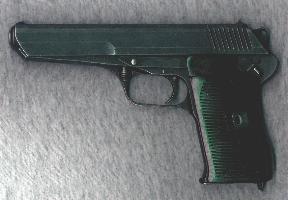 CZ52
Kirby
Sanders collection
|
The CZ52 uses the
unusual, high-powered but small diameter 7.62x25 caliber round.
The 7.62x25 round is essentially a old broomhandle Mauser
cartridge with more power. Russians are using this cartridge in
Tokarev pistols and the Shpagin and Sudajev submachine guns.
The relatively large
amount of powder behind the small projectile produces a slug with
a muzzle velocity of between 1300 and 1500 feet per second--
somewehere between the projectile speeds of the .357 magnum and a
.44 magnum cartridges.
The CZ52 is a large
semi-automatic pistol at 8.25 inches length and 5.5 inches
height. The barrel is about 4.75 inches in length. The CZ52 has
an eight-shot magazine and weighs approximately 2.75 pounds
loaded. Approximately 200,000 are believed to have been
manufactured during 1952-53 only.
In 1982 Czechoslovakia phased
the 7.62x25 caliber vzor 52 pistols out of use for the military.
Like many other nations worldwide, the Czechs moved to a 9mm
cartridge-standard with the CZ vzor 82 semi-automatic pistol. The
CZ50/70 line ceased production in 1981 and was replaced for
official use by the CZ vzor 82 and 83. The 9mm vzor 82 cartridge
is the same as 9 mm Makarov, but uses a solid-metal projectile of
porous steel. The CZ82 replaced the CZ52 in army use and the the
CZ vzor 50/70 in police use.
The CZ52 pistol was not the only
notable firearm produced by Ceska zbrojovka Uhersky Brod during
the cold war period. The vzor 52 and vzor 52/57 semi-automatic
rifles represented a surprising individualism in Czech firearms
design at a time when all of the Soviet-sphere countries were
standardizing to the SKS and later AK47 rifles. While similar in
dimensions, the 7.62x45 Czech cartridge was adopted without
consideration of standardizing to the Soviet 7.62x39.
 VZ52
AND 52/57
Kirby Sanders collection
|
VZ
52 & 52/57 TECHNICAL SPECIFICATION
|
| |
VZ 52
|
VZ 52/57
|
| Caliber |
7,62 mm |
7,62
mm |
| Velocity
V0 |
550
m/s |
550 m/s |
| Ammunition |
7,62
x 45 |
7,62
x 39 |
| Weight |
???
kg |
??? kg |
| Overall
length |
???
mm |
??? mm |
| Barrel
length |
???mm |
??? mm |
| Magazine
capacity |
10 |
10 |
| Effective
range |
500
m |
400 m |
|
The vzor 52 semi-automatic rifle
was produced from 1952 - 1958 in a unique 7.62 x 45 caliber.
Called by some collectors the "7.62x39 Magnum," the x45
cartridge was used solely for this one firearm.
By 1957, reportedly at Soviet
insistance and in the interest of Warsaw Pact standardization,
the Czechs began constructing vzor 52s in 7.62x39 caliber. This
variation, the vzor 52/57, was shortlived and in small quantity,
however.
Immediately after WWII,
the Czech Army used a grab-bag of German Mauser and Russian Mosin
Nagant bolt-action rifles as well as German G-43 semi-automatics.
While the standard vzor 52 semi-automatic rifle may bear some
first-glance similarities to the then-new Russian SKS, a close
inspection shows that the armorers at CZ adapted technology
similar to several models of firearm for their new battle-rifle.
The trigger assembly pays homage to the American M-1 Garand. The
gas-piston auto-reload system appears to be an adaptation from
the German MKb42 (w) design and the bolt system is similar to
that of the Belgian FN 49. The bayonet is attached and
side-mounted similar to that of the Russian Mosin Nagant m44.
The Rifle vzor 52 has
one unusual feature which has been known to startle more than one
first-time shooter. It ejects spent cartridges with fair force
but to the left of the shooter as opposed to the standard
"starboard side" ejection system common to most
semi-automatic firearms.
By the early 1960s, bowing to
the wishes of the Red Army and the standards of the Warsaw Pact,
this uniquely Czech firearm was phased out of service. The vzor
52and vzor 52/57 did not completely disappear from the world
stage. Toward the end of the Cold War, the ubiquitous vzor 52s
were found in use in Cuba, Grenada and Egypt as well as by some
Palestinian organizations. While the actual number of VZ52 and
VZ52/57 rifles produced remained secret, reliable estimates put
the number at 500,000.
In the early 1960s. all of the
remaining VZ52s were sold to Egypt and Syria and the Czech
production records were destroyed. Contrary to some speculation,
Egypt did not produce VZ52s. They merely purchased part of the
surplused balance.
By 1958 CZ had developed a new
rifle bearing some similarity to the Warsaw Pact standard AK47.
The Samopal vzor 58 (Samopal = Self firing). While the VZ58 may
bear some visual similarity to Mikhael Kalashnikov's design, it
is far from a simple clone of the immensely popular Kalashnikov
AK-47.
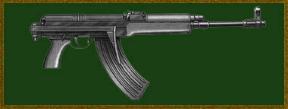 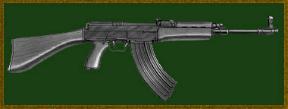
VZ58
configurations
Photo
courtesy of Arms Moravia
|
| VZ58 TECHNICAL
SPECIFICATION |
| Caliber |
7.62
mm |
| Velocity
V0 |
705
m/s |
| Ammunition |
7.62
x 39 |
| Weight
(with empty magazine) |
???
g |
| Weight
(with full magazine) |
???
g |
| Overall
length |
845
mm |
| Barrel
length |
390
mm |
| Magazine
capacity |
30 |
| Effective
range |
400
m |
| Rate
of fire |
800
rpm |
|
The Samopal vzor 58 is very
well-machined piece with milled-steel parts and is an expensive
weapon to produce. A fully-automatic carbine-length rifle in
Warsaw Pact standard 7.62x39 caliber, the VZ58 was produced in
folding-stock and solid wood-stock configurations. It uses a
standard 30-round magazine and is capable of firing about 800
rounds per minute.
Since the end of WW II,
Eastern-Bloc firearms development has been in the area of
simplifying manufacture by continuing to develop such techniques
as stampimg, pressing and welding parts as pioneered with the
Kalashnikov design.Another essential post-war design, however,
was pioneered by the Czechs.
That technical advance
is variously referred to as the "telescoping" or
"wrap-around" or "overhung" bolt. Czech
designer Vaclav Holek developed a bolt in such a way, that a
large amount of the mass was actually in front of the breech when
the bolt was in firing position. This was accomplished by
allowing the barrel to protrude into the receiver The front end
of the bolt is hollow so that tghe fore of the bolt actually
surrounds the barrel shank. Slots are cut in the overhung
portion, to permit feed and ejection. This configuration allowed
production of a shorter weapon with a longer barrel.
The first weapons to use the
over-hung bolt were the CZ vzor 23 and CZ vzor 25, both in 9 mm
Luger caliber introduced in the 1950s. The CZ 23 and 25 designs
inspired later developments which were incorporated ino the
Israeli UZI, French MAT and machine pistols made by Beretta,
Ingram and Walther.
 
CZ
23 AND 25
Photos
courtesy of ??
|
VZ23
& 25 TECHNICAL SPECIFICATION
|
| |
VZ 23
|
VZ 25
|
| Caliber |
9 mm |
9 mm |
| Velocity
V0 |
???
m/s |
??? m/s |
| Ammunition |
9
x 19 |
9 x
19 |
| Weight |
???kg |
??? kg |
| Overall
length |
???
mm |
??? mm |
| Overall
length wih extended stock |
xxx |
686
mm |
| Barrel
length |
???
mm |
??? mm |
| Magazine
capacity |
30 |
30 |
| Effective
range |
300
m |
300 m |
| Rate
of fire |
???
rpm |
??? rpm |
|
The CZ23 was designed with a wooden buff-stock while
the CZ25 had a side-folding metal stock. Again, the production
quantities of these firearms are unknown, having been held
secret.
An unknown number of VZ23s and VZ25s were sold to Cuba
during 1961and 1962. As with the Egyptian purchase of the VZ52
and 57 rifles, firearms were sold to Cuba but production rights
were not. Similar submachine guns were produced by the Republic
of South Africa, but these were not CZ-licensed production. Also
unknown is why CZ began the "20s" series numbering for
subguns and machine pistols rather than following the old-method
"Vzor and date" designations.
During World War II, American troops carried
"grease guns." During the 1950s, the
| Czech army and police services began
receiving "bicycle pumps." Nicknamed
for their appearance similar to air pumps for bicycle
tires, CZ24 and VZ26 submachine guns accomodated the
small but powerful 7.62x25 cartridge used in the CZ 52
pistols. The Vzor 24 and 26 fired 650 rounds per minute.
The VZ24 was produced in a solid-stock configuration
while the VZ26 was designed with a side-fold stock.
VZ24
& 26 TECHNICAL SPECIFICATIONS
|
| |
VZ 24
|
VZ 26
|
| Caliber |
7.62 mm |
7.62 mm |
| Velocity
V0 |
550
m/s |
550 m/s |
| Ammunition |
7.62
x 25 |
7.62 x
25 |
| Weight |
3.3
kg |
311 kg |
| Overall
length |
686
mm |
445 mm |
| Overall
length wih extended stock |
xxx |
686
mm |
| Barrel
length |
284
mm |
284 mm |
| Magazine
capacity |
32 |
32 |
| Effective
range |
300
m |
300 m |
| Rate
of fire |
650
rpm |
650 rpm |
|
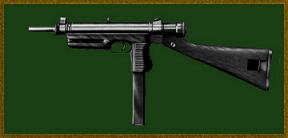 CZ24
Machinepistol
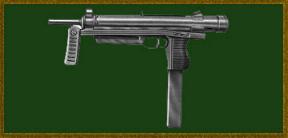
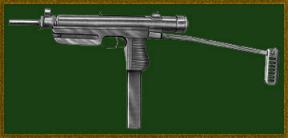
CZ26
Machinepistol
|
Following the Velvet Revolution and the fall of the
Iron Curtain, demilitarized VZ 24s and 26s were made available to
European collectors.
The VZ61 "Scorpion," a squarish machine with
distinct physical similarities to the Ingram or later Cobray
designs, was the next development in Czech submachine guns. The
"Scorpion" was designed by Miroslav Rybar and produced
during the early 1960s. Rybar, a talented designer, died at age
46-- a great loss to CZ and the fraternity of world firearms
designers and engineers.
The Scorpion fires a standard .32 caliber round at up
to 850 rounds per minute in full-auto mode and features a
top-fold stock. It was designed to take bananna-clip of either 10
or 20 rounds and was used by the Czech Army, Police and prison
guards. They were also built under license by Yugoslavia.
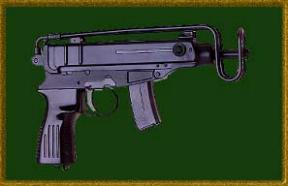 VZ61
Machinepistol
Photo
Courtesy of Arms Moravia
|
VZ61 TECHNICAL
SPECIFICATION
|
| Caliber |
Mod. 61E, 7.65
Browning (.32 ACP) |
| Overall length
with retracted stock |
270 mm |
| Overall lengh
with extended stock |
517 mm |
| Width with
retracted stock |
43 mm |
| Barrel length |
115 mm |
| Sight radius |
147 mm |
| Weight without
magazine |
1 280 g |
| Technical rate
of fire |
up to 850 rpm |
| Practical rate
of fire |
|
| - in
semi-automatic fire |
35 rpm |
| - in short
bursts fire |
110 rpm |
|
The Scorpion design was also developed in several
other calibers and configurations including the VZ64 which
accomodated .380 caliber rounds in 10 and 20 shot stick
magazines; the 9mm Makarov caliber VZ65 which used similar
stick-mags; the VZ68 in 9mm Luger, for which a 30-round stick
magazine was also available; the VZ82, which was another 9mm
Luger model and the VZ91 made for .380 caliber. Some of the
Scorpion types were also designed for semi-automatic fire.
The next step in the CZ pistol progression is the
CZ75. While earlier CZ semi-autos had a distincly European look
similar to the Mauser or Walther profiles, the CZ75 has a more
North-American "Browning" look to it. Using a
combination of reliable and fairly common semi-automatic firearm
principles, theCZ75 was designed by Frantisek Koutsky in the
early 1970s. It remains available under current commercial
production in 9mm Luger, 9mm x 21 and .40 Smith and Wesson
calibers. The CZ75 has a magazine capacity of 15 munds in the 9mm
configurations and 10 rounds the .40 S&W configuration.
| CZ75 TECHNICAL
SPECIFICATION |
| Caliber |
9
mm |
| Velocity
V0 |
???
m/s |
| Ammunition |
9 x
19 |
| Weight
(with empty magazine) |
1000
g |
| Weight
(with full magazine) |
???
g |
| Total
length |
206
mm |
| Height
of the gun |
138
mm |
| Barrel
length |
120
mm |
| Magazine
capacity |
16 |
| Effective
range |
50
m |
|
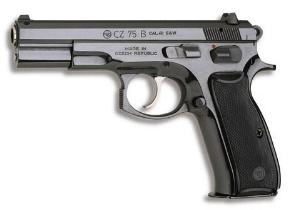 |
In 1982 Czechoslovakia phased most of the .32 and
7.62x25 caliber pistols out of use for the police and military.
Like many other nations worldwide, the Czech military and police
moved to a 9mm cartridge-standard with the CZ82 semi-automatic
pistol. The CZ82 takes a standard 9mm x 18 or 9mm Makarov
cartridge. For Czech official use, however, the issue round fires
a porous-steel modern ball round. The CZ82 is a standard
blow-back design with an external hammer and 12-shot magazine.
| CZ82 TECHNICAL
SPECIFICATION |
| Caliber |
9
mm |
| Velocity
V0 |
280
m/s |
| Ammunition |
9 x
18 |
| Weight
(with empty magazine) |
800
g |
| Weight
(with full magazine) |
915
g |
| Total
length |
172
mm |
| Height
of the gun |
123
mm |
| Barrel
length |
96
mm |
| Magazine
capacity |
6 |
| Effective
range |
50
m |
|
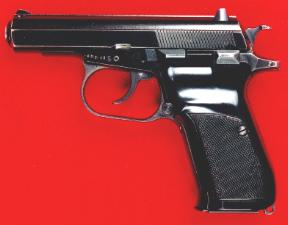 CZ82
Photo
Courtesy of Jan Balcar
|
|
The CZ83 is essentially a .32 caliber version of the
82 with a 16-shot magazine. TheCZ82 and 83 are generally issued
with an oversized "Winter" triggerguard to allow easy
use by officers wearing gloves.
Still in current production, the
CZ82 is now made in the original .32calibre, 9mm Browning and 9mm
Makarov.
The Koutsky design-model
continued with the improved 9mm Luger VZ85 in 1985, which
incorporated an ambidextrous safety and slide-catch lever).
While the guns of CZ were to
develop some reputation in Western Europe, the geopolitical fact
of German and then Russian control of the country from 1945 until
1989 made them rare in the United States. As the Iron Curtain
Rang down, however, A progressive and Western-oriented Czech
government was among the first to bolt the Soviet fold.
At the beginning of the l980s,
Czechoslovakia was led by pro-Soviet hardliner Gustav Husak.
Husak had assumed power immediate following the Warsaw Pact
invasion Of August 20,1968 which crushed a brief reformist period
known as the Prague Spring.
During the Prague Spring, the
government of Czechoslovakia came under the party leadership of
Alexander Dubcek who advocated an ahead-of-its-time version of
"perestroika" for his nation. Dubcek advocated
"Socialism with a human face," and essentially gave
government approval to strong grassroots pressures for a more
open and less restrictive government. Many of the influences
during the Prague Spring were the odd 1960s mix of cultural
politics. In some ways, the Prague Spring resembled San
Franciso's "Summer of Love" but with far greater
political repercussions.
By August, the Soviets were
leading a Warsaw Pact invasion to topple the moderated government
and bring a "renegade" Czechoslovakia (as well as
Communist Party Leader Dubcek) back into line. As the Soviets
replaced Dubcek and other "Prague Spring" leaders, some
150,000 Czechoslovakians fled their country. An elderly and
possibly senile Svoboda remained president-in-title until 1970,
however, other hard-line leaders oversaw a series of political
purges and oppression into the 1970s.
Husak was elected president by
the party in 1970 with the excuse that Svoboda was ill and could
not continue to govern. Husak led a government that many consider
to have been amongst the most oppressive communist regimes in
Eastern Europe.
Such a system did not sit well
with the Czech People, however. As the Communist bloc unraveled,
Czechoslovakia was amongst the first to move its policies
westward. As Mikhael Gorbachev sang the praises of Perestroika in
the 1980s, the Czech people took the message of freedom to heart.
Contrary to the wishes of reformer Gorbachev, however, the Husak
governement would not join the choir. A series of public
demonstrations against the government by the Czecho-Slovaks
between November 17 and December 29,1989 finally forced the
resignation of Husak and his government. What much of the world
calls "The Velvet Revolution" was a series of mostly
non-violent demonstrations, strikes and "discussion
groups" that eventually led to a bloodless
"revolution."
The 1989 demands and
demonstrations began on November 17-- the fiftieth anniversary of
Jan Opletal's funeral and the massive demonstrations against Nazi
occupation.
Dubcek returned as Speaker of
the General Assembly on December 10, 1989 after having spent the
years 1968 to 1988 assigned by the Husak government to the Slovak
Forestry Service. The next day, December 11, the general assembly
chose playwright and pro-reform leader Vaclav Havel as President
of the Republic and the Velvet Revolution was at an end. For
several internal national reasons, many Czechs do not like the
term "Vevet Revolution," (Sametova Revoluce in Czech)
preferring instead "Listopadove Udalosti"--the
"November Events."
Whether Listopadove Udalosti or
Sametova Revoluce, within a month after the November, 1989, fall
of the Berhn Wall, Czechoslovakia was a free state again. In the
1990 general elections, with 96 percent of Czechoslovaks people
voting, the Communist Party was resoundingly removed and replaced
by pro-west leadership including Havel.
In 1992 the history of
Czechoslovakia itself took another unique twist as the nation
chose peaceably to divide into the Czech Republic and the Slovak
Republic. Among the issues in that division was a desire for
rapid privatization of industry and western alliance by the
Czechs and a slower-paced switch to new systems by the Slovaks.
No one can deny that the division of the old Republic was a
painful national experience, but it has proven to be an amicable
"divorce" and, again, a peaceful resolution to a
situation over which numerous wars have erupted.
As the Century turns, the modern
Czech military is outfitted with CZ82 sidearms. The Police forces
still use small numbers of CZ 50s, 70s, 82s and 83s, but theCZ75
and the CZ85 in 9mm Luger are the standard firearms for domestic
protection.
Since independence, American
firearms collectors have come to respect the fine Czech
craftsmanhip mainly by way of the CZ5O and CZ52 pistols and VZ52
rifles. The main exporter of Czech surplus firearms is Arms
Moravia in Ostrava, Czech Republic.
(Need
brief history and Interview with Arms Moravia about company)
Collector arms are not the only
avenue by which The Guns of CZ have made inroads into the United
States. Ceska Zbrojovka Uhersky Brod entered the United States
via importation agreements with several American distributors
beginning in 1991. By 1997, the company had established its own
North American subsidiary in temporary headqurters at Oakhurst,
California. In 1998, CZ USA had established its corporate home in
Kansas City, Kansas.
Since then, CZ has proven to be
a force in the new-gun market with production of nine basic
semi-automatic pistol models in several calibers for the
commercial market. CZ also makes two basic models and several
variants of .22 caliber rimfire rifles and two basic models of
centerfire hunting rifles in an array of calibers.
Among the more unusual of CZ-UBs
current-production rifles is a bolt-action hunter designed in
7.62x39 caliber, a caliber generally considered only in context
of the SKS and AK47 military guns.
CZ-UB has also branched into
production of four lines of airguns and three lines of
"over-under" shotguns. The tradition for submachine
guns and other automatic weapons also continues with production
of those firearms for the military and law-enforcement market.
The CZ-UB exhibition and
competition shooting have also made a fast and impressive name
for themselves in the International Practical Shooting
Confederation. Pavel Jasansky of the CZ team won the 1999 IPSC
World Shoot using a modified CZ75 pistol.
Ceskoslovenska Zbrojovka Brno
has not disappeared completely either. They currently offer a
line of
The fall of the Iron Curtain and the rise of a
western-oriented government since independence has proven to be
solid fuel for the deserved rise in reputation of the long
overlooked Guns of Czechoslovakia.
Email kirby here
Link to kirby's website here


































